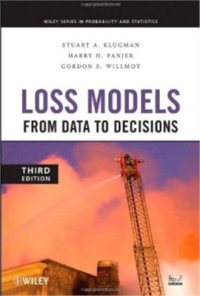
Ebook: Loss Models: From Data to Decisions
- Genre: Economy // Mathematical Economics
- Tags: Финансово-экономические дисциплины, Математические методы и моделирование в экономике
- Language: English
- pdf
Wiley, 2008. – 760 p. – 3rd ed. – ISBN: 0470187816, 9780470391334An update of one of the most trusted books on constructing and analyzing actuarial models
Written by three renowned authorities in the actuarial field, Loss Models, Third Edition upholds the reputation for excellence that has made this book required reading for the Society of Actuaries (SOA) and Casualty Actuarial Society (CAS) qualification examinations. This update serves as a complete presentation of statistical methods for measuring risk and building models to measure loss in real-world events.
This book maintains an approach to modeling and forecasting that utilizes tools related to risk theory, loss distributions, and survival models. Random variables, basic distributional quantities, the recursive method, and techniques for classifying and creating distributions are also discussed. Both parametric and non-parametric estimation methods are thoroughly covered along with advice for choosing an appropriate model. Features of the Third Edition include:
Extended discussion of risk management and risk measures, including Tail-Value-at-Risk (TVaR)
New sections on extreme value distributions and their estimation
Inclusion of homogeneous, nonhomogeneous, and mixed Poisson processes
Expanded coverage of copula models and their estimation
Additional treatment of methods for constructing confidence regions when there is more than one parameter
The book continues to distinguish itself by providing over 400 exercises that have appeared on previous SOA and CAS examinations. Intriguing examples from the fields of insurance and business are discussed throughout, and all data sets are available on the book's FTP site, along with programs that assist with conducting loss model analysis.
Loss Models, Third Edition is an essential resource for students and aspiring actuaries who are preparing to take the SOA and CAS preliminary examinations. It is also a must-have reference for professional actuaries, graduate students in the actuarial field, and anyone who works with loss and risk models in their everyday work.Contents:
Preface.
Introduction.
Modeling.
Random variables.
Basic distributional quantities.
Actuarial Models.
Characteristics of actuarial models.
Continuous models.
Discrete distributions and processes.
Multivariate models.
Frequency and severity with coverage modifications.
Aggregate loss models.
Discrete-time ruin models.
Continuous-time ruin models.
Construction of Empirical Models.
Review of mathematical statistics.
Estimation for complete data.
Estimation for modified data.
Parametric Statistical Methods.
Parameter estimation.
Model selection.
Estimation and model selection for more complex models.
Five examples.
Adjusted Estimates.
Interpolation and smoothing.
Credibility.
Simulation.Appendix A: An inventory of continuous distributions.
Appendix B: An inventory of discrete distributions.
Appendix C: Frequency and severity relationships.
Appendix D: The recursive formula.
Appendix E: Discretization of the severity distribution.
Appendix F: Numerical optimization and solution of systems of equations.
References.
Index.
Written by three renowned authorities in the actuarial field, Loss Models, Third Edition upholds the reputation for excellence that has made this book required reading for the Society of Actuaries (SOA) and Casualty Actuarial Society (CAS) qualification examinations. This update serves as a complete presentation of statistical methods for measuring risk and building models to measure loss in real-world events.
This book maintains an approach to modeling and forecasting that utilizes tools related to risk theory, loss distributions, and survival models. Random variables, basic distributional quantities, the recursive method, and techniques for classifying and creating distributions are also discussed. Both parametric and non-parametric estimation methods are thoroughly covered along with advice for choosing an appropriate model. Features of the Third Edition include:
Extended discussion of risk management and risk measures, including Tail-Value-at-Risk (TVaR)
New sections on extreme value distributions and their estimation
Inclusion of homogeneous, nonhomogeneous, and mixed Poisson processes
Expanded coverage of copula models and their estimation
Additional treatment of methods for constructing confidence regions when there is more than one parameter
The book continues to distinguish itself by providing over 400 exercises that have appeared on previous SOA and CAS examinations. Intriguing examples from the fields of insurance and business are discussed throughout, and all data sets are available on the book's FTP site, along with programs that assist with conducting loss model analysis.
Loss Models, Third Edition is an essential resource for students and aspiring actuaries who are preparing to take the SOA and CAS preliminary examinations. It is also a must-have reference for professional actuaries, graduate students in the actuarial field, and anyone who works with loss and risk models in their everyday work.Contents:
Preface.
Introduction.
Modeling.
Random variables.
Basic distributional quantities.
Actuarial Models.
Characteristics of actuarial models.
Continuous models.
Discrete distributions and processes.
Multivariate models.
Frequency and severity with coverage modifications.
Aggregate loss models.
Discrete-time ruin models.
Continuous-time ruin models.
Construction of Empirical Models.
Review of mathematical statistics.
Estimation for complete data.
Estimation for modified data.
Parametric Statistical Methods.
Parameter estimation.
Model selection.
Estimation and model selection for more complex models.
Five examples.
Adjusted Estimates.
Interpolation and smoothing.
Credibility.
Simulation.Appendix A: An inventory of continuous distributions.
Appendix B: An inventory of discrete distributions.
Appendix C: Frequency and severity relationships.
Appendix D: The recursive formula.
Appendix E: Discretization of the severity distribution.
Appendix F: Numerical optimization and solution of systems of equations.
References.
Index.
Download the book Loss Models: From Data to Decisions for free or read online
Continue reading on any device:

Last viewed books
Related books
{related-news}
Comments (0)